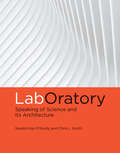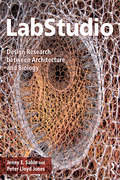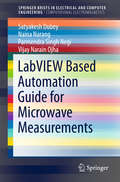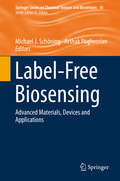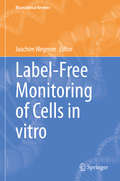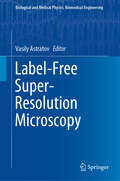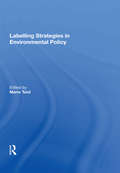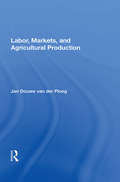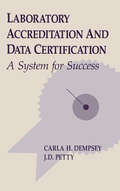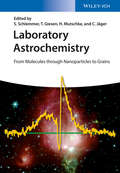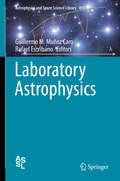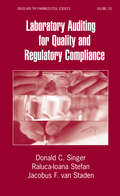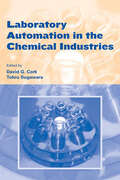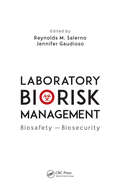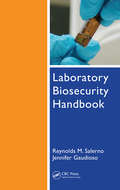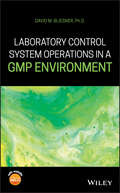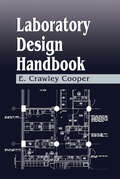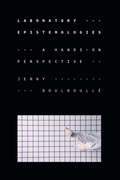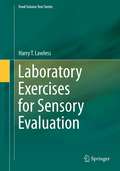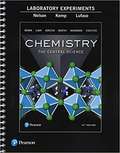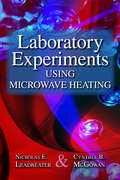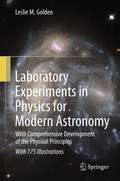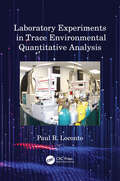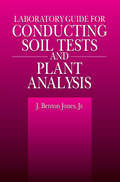- Table View
- List View
LabOratory: Speaking of Science and Its Architecture (The\mit Press Ser.)
by Chris L. Smith Sandra Kaji-O'GradyAn illustrated examination of laboratory architecture and the work that it does to engage the public, recruit scientists, and attract funding.The laboratory building is as significant to the twenty-first century as the cathedral was to the thirteenth and fourteenth centuries. The contemporary science laboratory is built at the grand scales of cathedrals and constitutes as significant an architectural statement. The laboratory is a serious investment in architectural expression in an attempt to persuade us of the value of the science that goes on inside. In this lavishly illustrated book, Sandra Kaji-O'Grady and Chris L. Smith explore the architecture of modern life science laboratories, and the work that it does to engage the public, recruit scientists, and attract funding.Looking at the varied designs of eleven important laboratories in North America, Europe, and Australia, all built between 2005 and 2019, Kaji-O'Grady and Smith examine the relationship between the design of contemporary laboratory buildings and the ideas and ideologies of science. Observing that every laboratory architect and client declares the same three aspirations—to eliminate boundaries, to communicate the benefits of its research programs, and to foster collaboration—Kaji-O'Grady and Smith organize their account according to the themes of boundaries, expression, and socialization. For instance, they point to the South Australian Health and Medical Institute's translucent envelope as the material equivalent of institutional accountability; the insistent animal imagery of the NavarraBioMed laboratory in Spain; and the Hillside Research Campus's mimicry of the picturesque fishing village that once occupied its site. Through these and their other examples, Kaji-O'Grady and Smith show how the architecture of the laboratory shapes the science that takes place within it.
LabStudio: Design Research between Architecture and Biology
by Jenny E. Sabin Peter Lloyd JonesLabStudio: Design Research between Architecture and Biology introduces the concept of the research design laboratory in which funded research and trans-disciplinary participants achieve radical advances in science, design, and applied architectural practice. The book demonstrates to natural scientists and architects alike new approaches to more traditional design studio and hypothesis-led research that are complementary, iterative, experimental, and reciprocal. These originate from 3-D spatial biology and generative design in architecture, creating philosophies and practices that are high-risk, non-linear, and design-driven for often surprising results.Authors Jenny E. Sabin, an architectural designer, and Peter Lloyd Jones, a spatial biologist, present case studies, prototypes, and exercises from their practice, LabStudio, illustrating in hundreds of color images a new model for seemingly unrelated, open-ended, data-, systems- and technology-driven methods that you can adopt for incredible results.
LabVIEW based Automation Guide for Microwave Measurements
by Satya Kesh Dubey Naina Narang P. S. Negi V. N. OjhaThe book is focused on measurement automation, specifically using the LabView tool. It explains basic measurements in a simplified manner with appropriate step-by-step explanations and discussions of instrument capabilities. It touches upon aspects of measurement science, microwave measurements and software development for measurement. The book can be used as a guide by technicians, researchers and scientists involved in metrology laboratories to automate measurements. The book explains the development process for automation of measurement systems for every step of the software development lifecycle. It covers system design and automation policy creation. The book uses a top-down approach which enables the reader to relate their own problems and develop a system with their own analysis. The book includes many examples, illustrations, flowcharts, measurement results and screenshots of a worked-out automation software for microwave measurement. The book includes discussions on microwave measurements-attenuation, microwave power and E-field strength. The contents of this book will be of interest to students, researchers and scientists working in the field of electromagnetism, antennas, communication and electromagnetic interference/electromagnetic compatibility (EMI/EMC).
Label-Free Biosensing: Advanced Materials, Devices and Applications (Springer Series on Chemical Sensors and Biosensors #16)
by Michael J. Schöning Arshak PoghossianThis volume summarizes the state-of-the-art technologies, key advances and future trends in the field of label-free biosensing. It provides detailed insights into the different types of solid-state, label-free biosensors, their underlying transducer principles, advanced materials utilized, device-fabrication techniques and various applications. The book offers graduate students, academic researchers, and industry professionals a comprehensive source of information on all facets of label-free biosensing and the future trends in this flourishing field. Highlights of the subjects covered include label-free biosensing with:· semiconductor field-effect devices such as nanomaterial-modified capacitive electrolyte-insulator-semiconductor structures, silicon nanowire transistors, III-nitride semiconductor devices and light-addressable potentiometric sensors· impedimetric biosensors using planar and 3D electrodes· nanocavity and solid-state nanopore devices · carbon nanotube and graphene/graphene oxide biosensors· electrochemical biosensors using molecularly imprinted polymers· biomimetic sensors based on acoustic signal transduction· enzyme logic systems and digital biosensors based on the biocomputing concept· heat-transfer as a novel transducer principle· ultrasensitive surface plasmon resonance biosensors · magnetic biosensors and magnetic imaging devices
Label-Free Monitoring of Cells in vitro (Bioanalytical Reviews #2)
by Joachim WegenerThis book is dedicated to label-free, non-invasive monitoring of cell-based assays and it comprises the most widely applied techniques. Each approach is described and critically evaluated by an expert in the field such that researchers get an overview on what is possible and where the limitations are. The book provides the theoretical basis for each technique as well as the most successful and exciting applications.Label-free bioanalytical techniques have been known for a long time as valuable tools to monitor adsorption processes at the solid-liquid interface in general – and biomolecular interaction analysis (BIA) in particular. The underlying concepts have been progressively transferred to the analysis of cell-based assays. The strength of these approaches is implicitly given with the name 'label-free': the readout is independent of any label, reagent or additive that contaminates the system under study and potentially affects its properties. Thus, label-free techniques provide an unbiased analytical perspective in the sense that the sample is not manipulated by additives but pure. They are commonly based on physical principles and read changes in integral physical properties of the sample like refractive index, conductivity, capacitance or elastic modulus to mention just a few. Even though it is not implied in the name, label-free approaches usually monitor the cells under study non-invasively meaning that the amplitude of the signal (e.g. electric field strength, mechanical elongation) that is used for the measurement is too low to interfere or affect. In contrast to label-based analytical techniques that are commonly restricted to a single reading at a predefined time point, label-free approaches allow for a continuous observation so that the dynamics of the biological system or reaction become accessible.
Label-Free Super-Resolution Microscopy (Biological and Medical Physics, Biomedical Engineering)
by Vasily AstratovThis book presents the advances in super-resolution microscopy in physics and biomedical optics for nanoscale imaging. In the last decade, super-resolved fluorescence imaging has opened new horizons in improving the resolution of optical microscopes far beyond the classical diffraction limit, leading to the Nobel Prize in Chemistry in 2014. This book represents the first comprehensive review of a different type of super-resolved microscopy, which does not rely on using fluorescent markers. Such label-free super-resolution microscopy enables potentially even broader applications in life sciences and nanoscale imaging, but is much more challenging and it is based on different physical concepts and approaches. A unique feature of this book is that it combines insights into mechanisms of label-free super-resolution with a vast range of applications from fast imaging of living cells to inorganic nanostructures. This book can be used by researchers in biological and medical physics. Due to its logically organizational structure, it can be also used as a teaching tool in graduate and upper-division undergraduate-level courses devoted to super-resolved microscopy, nanoscale imaging, microscopy instrumentation, and biomedical imaging.
Labelling Strategies in Environmental Policy
by Mario TeislEco-labelling programmes have been in existence for many years but their recent growth now extends to many products and services. The academic literature has grown in response and there have been several theoretical and empirical advances. This volume presents the best of previously published research on the design and effects of eco-labelling programmes. Whilst concentrating on the economic literature, the articles also approach the topic from a psychological, sociological and political point of view. Part One focuses on a range of theoretical developments, Part Two on empirical measurements of the effectiveness of eco-labelling, Part Three on the factors that influence the success and design of eco-labelling programmes and Part Four on the effects of eco-labelling on international trade and development.
Labor, Markets, And Agricultural Production
by Jan Douwe van der PloegFocusing on the complex and often contradictory relationships between agricultural production and markets, Labor, Markets, and Agricultural Production examines the micro-macro linkages between farm production, farm labor issues, and the degree of autonomy or dependency vis-Ã -vis markets. By comparing the case of farmers in Peru, generally regarded as peripheral agricultural producers, with that of European farmers able to easily access the centralized markets of the EEC, Dr. van der Ploeg is able to draw general conclusions about the ongoing process of commoditization of agriculture and the roles farmers play in agrarian development.
Laboratory Accreditation and Data Certification: A System for Success
by Carla H. Dempsey Jimmie D. PettyThis book provides descriptions of current laboratory accreditation schemes and explains why these schemes fall short of assuring data purchasers that the data produced from accredited laboratories are always quality products. The book then presents a system for laboratory accreditation in conjunction with data certification that assures data purchasers their data are useful for the purposes for which they are intended. Simple quality assurance and quality control techniques, in addition to concepts of total quality management, are described and then applied to the environmental laboratory industry. This "System For Success" was developed from real problems and real solutions within the industry and represents an integration of proven techniques that offer a better way to ensure quality laboratory data is obtained. Laboratory Accreditation: A Workable Solution is a must for government officials, environmental professionals, independent environmental laboratories, hazardous waste disposal industries, chemical manufacturers, QA professionals, and testing laboratories.
Laboratory Astrochemistry
by Thomas Giesen Stephan Schlemmer Harald MutschkeWritten by leading scientists in the field and intended for a broader readership, this is an ideal starting point for an overview of current research and developments. As such, the book covers a broad spectrum of laboratory astrophysics and chemistry, describing recent advances in experiments, as well as theoretical work, including fundamental physics and modeling chemical networks. For researchers as well as students and newcomers to the field.
Laboratory Astrophysics (Astrophysics and Space Science Library #451)
by Guillermo M. Muñoz Caro Rafael EscribanoThis book focuses on the most recent, relevant, comprehensive and significant aspects in the well-established multidisciplinary field Laboratory Astrophysics. It focuses on astrophysical environments, which include asteroids, comets, the interstellar medium, and circumstellar and circumplanetary regions. Its scope lies between physics and chemistry, since it explores physical properties of the gas, ice, and dust present in those systems, as well as chemical reactions occurring in the gas phase, the bare dust surface, or in the ice bulk and its surface. Each chapter provides the necessary mathematical background to understand the subject, followed by a case study of the corresponding system. The book provides adequate material to help interpret the observations, or the computer models of astrophysical environments. It introduces and describes the use of spectroscopic tools for laboratory astrophysics. This book is mainly addressed to PhD graduates working in this field or observers and modelers searching for information on ice and dust processes.
Laboratory Auditing for Quality and Regulatory Compliance
by Donald C. Singer Raluca-Ioana Stefan Jacobus F. van StadenIdentifying current tools, techniques, and approaches for the evaluation of laboratory operations, this reference reviews the latest regulatory standards and auditing practices to test laboratory safety, quality, and performance.
Laboratory Automation in the Chemical Indus
by David G. Cork Tohru SugawaraFeaturing extensive calculations and examples, this reference discusses theoretical and practical aspects of short-circuit currents in ac and dc systems, load flow, and harmonic analyses to provide a sound knowledge base for modern computer-based studies that can be utilized in real-world applications. Presenting more than 2300 figures, tables, and equations, the author explores matrix methods for network solutions and includes load flow and optimization techniques. He discusses ac and dc short-circuit systems calculations in accordance with standards set by the American National Standards Institute (ANSI) and the International Electrotechnical Commission (IEC).
Laboratory Biorisk Management: Biosafety and Biosecurity
by Reynolds M. Salerno Jennifer GaudiosoOver the past two decades bioscience facilities worldwide have experienced multiple safety and security incidents, including many notable incidents at so-called "sophisticated facilities" in North America and Western Europe. This demonstrates that a system based solely on biosafety levels and security regulations may not be sufficient.Setting the s
Laboratory Biosecurity Handbook
by Reynolds M. Salerno Jennifer Gaudioso Benjamin H. BrodskyIn recognition of the vital need to protect legitimate facilities from the theft and misuse of dangerous pathogens and toxins, the Laboratory Biosecurity Handbook serves as a guide to the implementation of pathogen protection programs. The first sections of the book offer an historical overview of biological weapons activity, key principles of biosecurity and its integration into existing frameworks, as well as a discussion of biosecurity risk. Later sections discuss biosecurity risk assessments, describe detailed components of a biosecurity program, and offer a graded approach to biosecurity through multiple risk levels. The work also covers risk prioritization of biological assets and biosecurity training.
Laboratory Control System Operations in a GMP Environment
by David M. BliesnerDevelop an understanding of FDA and global regulatory agency requirements for Laboratory Control System (LCS) operations In Laboratory Control System Operations in a GMP Environment, readers are given the guidance they need to implement a CGMP compliant Laboratory Control System (LCS) that fits within Global Regulatory guidelines. Using the Quality Systems Approach, regulatory agencies like the FDA and the European Medicine Agency have developed a scheme of systems for auditing pharmaceutical manufacturing facilities which includes evaluating the LCS. In this guide, readers learn the fundamental rules for operating a CGMP compliant Laboratory Control System. Designed to help leaders meet regulatory standards and operate more efficiently, the text includes chapters that cover Laboratory Equipment Qualification and Calibration, Laboratory Facilities, Method Validation and Method Transfer, Laboratory Computer Systems, Laboratory Investigations as well as Data Governance and Data Integrity. The text also includes chapters related to Laboratory Managerial and Administrative Systems, Laboratory Documentation Practices and Standard Operating Procedures and General Laboratory Compliance Practices. Additionally, a chapter outlining Stability Program operations is included in the text. In addition to these topics, it includes LCS information and tools such as: ● End of chapter templates, checklists, and LCS guidance to help you follow the required standards ● Electronic versions of each tool so users can use them outside of the text ● An In-depth understanding of what is required by the FDA and other globally significant regulatory authorities for GMP compliant systems For quality assurance professionals working within the pharmaceutical or biopharma industries, this text provides the insight and tools necessary to implement government-defined regulations.
Laboratory Design Handbook
by E. Crawley CooperLaboratory Design Handbook describes the process, motivation, constraints, challenges, opportunities, and specific design data related to the creation of a modern research laboratory. The information presented is based on a large pool of experience in the development of new and renovated laboratory buildings for universities, teaching hospitals, ph
Laboratory Epistemologies: A Hands-On Perspective (Experimental Futures)
by Jenny BoulboulléIn Laboratory Epistemologies: A Hands-On Perspective, Jenny Boulboullé examines the significance of hands-on experiences in contemporary life sciences laboratories. Addressing the relationship between contemplation and manipulation in epistemology, Boulboullé combines participant observations in molecular genetics labs and microbiological cleanrooms with a longue durée study of the history and philosophy of science. She radically rereads Descartes’s key epistemological text Meditations on First Philosophy, reframing the philosopher as a hands-on knowledge maker. With this reading, Boulboullé subverts the pervasive modern conception of the disembodied knower and puts the hands-on experimenter at the heart of life sciences research. In so doing, she contributes a theoretical model for understanding how life processes on cellular and molecular levels are manually produced in today’s techno-scientific spaces. By reassessing the Cartesian legacy and arguing that epistemology should be grounded in the standpoint of a hands-on practitioner, Boulboullé offers the philosophical and historical foundation to understand and study contemporary life sciences research as multisensory embodied practices.
Laboratory Exercises for Sensory Evaluation
by Harry T. LawlessLaboratory exercises are a necessary part of science education. They enable students to better understand the principles discussed in lectures, and provide them with hands-on experience of the practical aspects of scientific research. The purpose of this book is to provide students and instructors with a time-tested set of lab exercises that illustrate the common sensory tests and/or sensory principles used in evaluation of foods, beverages and consumer products. The appendices will also include a set of simple problem sets that can be used to teach and reinforce basic statistical tests. Approximately twenty years ago the Sensory Evaluation Division of the Institute of Food Technologists sponsored the preparation of a set of exercises titled "Guidelines for Laboratory Exercises for a Course in Sensory Evaluation of Foods," edited by one of the co-authors (Heymann). This book will provide additional materials from the second author (Lawless), as well as other instructors, in a uniform format that can be easily adopted for course use. Most importantly, the lab exercises will complement the flagship textbook in the field, Sensory Evaluation of Foods: Principles and Practices, 2E, also by Lawless and Heymann and published by Springer. Possible course adoption of the main text along with the lab manual should enhance the sales of these materials.
Laboratory Experiments Chemistry: The Central Science
by John H. Nelson Kenneth C. Kemp Michael LufasoThis manual contains 43 finely tuned experiments chosen to introduce basic lab techniques and to illustrate core chemical principles. In the 14th Edition, all experiments were carefully edited for accuracy, safety, and cost. Pre-labs and questions were revised and new experiments added concerning solutions, polymers, and hydrates. Each of the experiments is self-contained, with sufficient background material, to conduct and understand the experiment. Each has a pedagogical objective to exemplify one or more specific principles. <P><P> Because the experiments are self-contained, they may be undertaken in any order, although the authors have found in their General Chemistry course that the sequence of Experiments 1 through 7 provides the firmest background and introduction. The authors have included pre-lab questions to answer before starting the lab. The questions are designed to help in understanding the experiment, learning how to do the necessary calculations to treat their data, and as an incentive for reading the experiment in advance. These labs can also be customized through Pearson Collections, our custom database program.
Laboratory Experiments Using Microwave Heating
by Nicholas E. Leadbeater Cynthia B. McGowanAllowing many chemical reactions to be completed within minutes, microwave heating has revolutionized preparative chemistry. As a result, this technology has been widely adopted in both academic and industrial laboratories. Integrating microwave-assisted chemistry into undergraduate laboratory courses enables students to perform a broader range of
Laboratory Experiments in Physics for Modern Astronomy
by Leslie M. GoldenThis book presents experiments which will teach physics relevant to astronomy. The astronomer, as instructor, frequently faces this need when his college or university has no astronomy department and any astronomy course is taught in the physics department. The physicist, as instructor, will find this intellectually appealing when faced with teaching an introductory astronomy course. From these experiments, the student will acquire important analytical tools, learn physics appropriate to astronomy, and experience instrument calibration and the direct gathering and analysis of data. Experiments that can be performed in one laboratory session as well as semester-long observation projects are included.
Laboratory Experiments in Trace Environmental Quantitative Analysis
by Paul R. LocontoLaboratory Experiments in Trace Environmental Quantitative Analysis is a collection of student-tested experiments that introduce important principles that underlie various laboratory techniques in the field of trace environmental organics and inorganics quantitative analysis. It crosses the more traditional academic disciplines of environmental science and analytical chemistry. The text is organized to begin with minimally rigorous session/experiments and increase in rigor as each session/experiment unfolds. Each experiment features learning objectives, expected student outcomes, and suggestions for further study. Additional features include: Students are introduced to the principles and laboratory practice of instrumental analysis (determinative techniques) that are clearly presented. Students are carefully taken through various ways to prepare samples for trace quantitative analysis (sample prep techniques). Safety warnings are listed within each experiment. Students are introduced to all three types of instrument calibration: external, internal and standard addition. Instructors who are responsible for laboratory courses in analytical chemistry with potential application to environmental sample matrices will find this textbook of value. Graduate programs in environmental science and engineering will also greatly benefit from the content.
Laboratory Fundamentals of Microbiology (Eleventh Edition)
by Jeffrey C. PommervilleLaboratory Fundamentals of Microbiology
Laboratory Guide for Conducting Soil Tests and Plant Analysis
by Jr., J. JonesWith the help of this guide, you can use obtained test results to evaluate the fertility status of soils and the nutrient element status of plants for crop production purposes. It serves as an instructional manual on the techniques used to perform chemical and physical characteristic tests on soils. Laboratory Guide for Conducting Soil Tests and Pl
